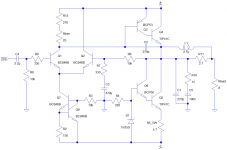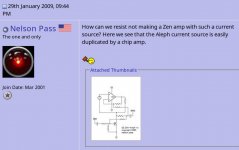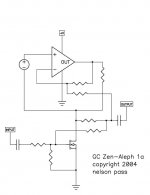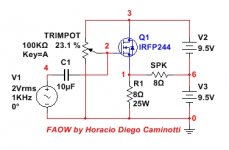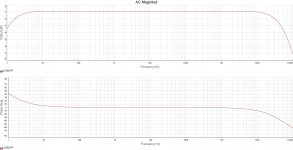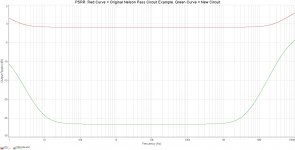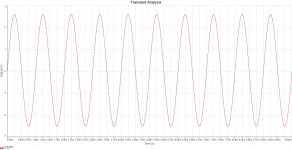View attachment 692590
And the balanced version. Fully DC coupled for the brave.
Closely matched P-channel FETs is important to minimize DC-offset.
This amp with bulbs instead of 6R resistors.
Can it be fed at pos input and neg input from the DAC without connecting the gnd of dac do the gnd of amp?
As the DAC has 3V DC on each output, if I don't connect the ground, I could go without coupling caps...
Build flea class A with Texas Instruments LM3886 chip for Aleph CCS purpose. Mr Pass solutions are " my cup of tea ".LM3886 THD+N <0.002% from 1 to 10W.
Cheers,
Patrick
Or 1 watt Super Symmetry amplifier who knows ?
Attachments
Member
Joined 2009
Paid Member
My personal response to this entertainment provides two peculiarities: the output capacitor is eliminated, so that the lower cutoff frequency is partially defined by capacitor C1 and the attenuation slope at low frequency of the buffer becomes 6 dB per octave and not 12 dB per octave; another parameter that is very favored with the changes is the PSRR, which increases significantly within the audible band (for example, the difference reaches 25.72 dB at 1KHz).It's a slow day. Time for a little entertainment - a micro project!
Someone sent me a request for a simple 1 watt amplifier.
How could I resist?
My answer:
Assuming that your preamp can put out 2 volts (and it should),
a 1 watt design would be the easiest thing in the world.
Attached is an example.
I will put it up on the Pass Labs forum at diyaudio and see
what kind of suggestions it gets for construction and improvement.
Feel free to post questions.
"Zen Mod" will likely be the first to take the bait.
The following draws 1.5A off a 19V computer desktop supply and gets
1 watt into 8 ohms at about .5% THD.

C1 simultaneously defines the lower cutoff frequency and the low frequency PSRR (together with the impedance of the previous stage), so it is necessary to define which value finally we should choose as a compromise solution.
My strategy was to connect the speaker between two almost equally noisy points, so that they tend to be suppressed
Regards
Diego
Attachments
Last edited:
Is there a similar DIYAudio thread for a low power push/pull class A build. Perhaps driving a [FONT=Verdana, Helvetica, Arial, san-serif]FE166En Haruna.[/FONT] I have a cabin off the grid. I am supplementing a 60 year old propane generator with a solar array. I plan to have a +/- 24V Lithium pack. Out of respect for the forest (and the law) I can not run the generator at night but I would like to relax to about 4 hours of night time music. The digital front end would run from the inverter. The analog electronics from batteries. Thus, I am calculating array wattage and storage capacity. Build suggestions? Existing DIYAudio thread?
Last edited:
Is there a similar DIYAudio thread for a low power push/pull class A build. Perhaps driving a [FONT=Verdana, Helvetica, Arial, san-serif]FE166En Haruna.[/FONT] I have a cabin off the grid. I am supplementing a 60 year old propane generator with a solar array. I plan to have a +/- 24V Lithium pack. Out of respect for the forest (and the law) I can not run the generator at night but I would like to relax to about 4 hours of night time music. The digital front end would run from the inverter. The analog electronics from batteries. Thus, I am calculating array wattage and storage capacity. Build suggestions? Existing DIYAudio thread?
I will soon be in a similar situation--off grid. I would choose a Pass Class A amplifier that can source current in excess of its bias current and reduce the bias to give a few watts in Class A, but will give more power if required in class A/B.
I will soon be in a similar situation--off grid.
Fostex offers a 5W RMS amplifier for their full range drivers.what level of power consumption is acceptable , both channels?
AP05.pdf
The AP05 appears to consume 22W at 2X5W RMS output. Power supply 12V at 1.5A
The PS appears to be a little light. Running this amplifier full bore for an hour would require approximately 25 Wh of battery storage. Or, 1KW of storage for 40 hours. I am looking at a 1 KW array with maybe 4-6 hours of light. Plus I have a 2 KW propane backup. I may want the option of running an electric refrigerator (currently propane). I would have to dig up my old notes but I think I am looking at 2 KWh of storage. I don't want to drain the system on a daily basis. And I need reserve for charging power tools etc.
Perhaps a 5W class A would be a reasonable target. The XA25, at idle, draws approximately 10X its rated output into 8 ohms (240 W). A 5W class A amplifier, in kind, might be expected to draw 50W at idle. A 1 KWh battery ought to provide upwards to 20 hours of listening time for a 5W class A. Not accounting for inefficiencies in power inversion etc if running 120 VAC. I don't need that much time. I have to go fishing.
Bottom line. It seems that 5W per channel class A would be a reasonable target. Plus, I think there are more efficient drivers than Fostex. The DIY full range driver forum has an overwhelming amount of information. Once I get a little further along, I may start a FAO5W thread.
A dead DIY Audio thread from 2013
5-watt-amplifier-madisound
Last edited:
Now that I have returned to looking at my notes of a few years ago I am reminded that I shall go with a commercial battery bank. Although I could build a lithium storage solution, if I burn down the forest I could be in a world of trouble akin to Pacific Gas and Electric. The Tesla PowerWall is way overkill. But I have not found a "baby" PowerWall equivalent. Nonetheless, I am apt to have 1-2 kWh storage. Thus, it does not make sense for me to run audio equipment on batteries when I can simply plug them it into the wall. I am using a quality turnkey solution that includes a pure sine wave inverter. The cabin has modern code 110V AC wiring. Nonetheless, I think I will target a 1-5W class A amplifier to drive an FE166/168 in a horn. But with a traditional power supply. If I fail at this, I may buy another XA25. Having an XA25 reference; tough act to follow. I hope to have made progress by July.I will soon be in a similar situation--off grid. I would choose a Pass Class A amplifier that can source current in excess of its bias current and reduce the bias to give a few watts in Class A, but will give more power if required in class A/B.
Last edited:
ZM. Thank you so much for your suggestion. I have been going through my parts bins. I have 8 matched SemiSouth E120R100 devices. I must have bought these with an FW project in mind. Which one? I don't think that I want to mess with them at my current level of expertise.outputs IRFP240 .. or maybe IRF510 for slightly sweeter even if looser sound
dissipation in range of 30W per channel , good for 5W/8R
Meanwhile I have a bunch of IXTH6N50D2 devices. I must have been thinking of the De-lite.
I also have a bunch of IXTP08N50D2 devices. N channel depletion devices. As I read the characteristic curves; it looks like they draw 1.4A at Vgs=0. I think I might be able to adapt these to the schematic that is the focus of this thread. Thus, for the circuit of this thread. Because I have a bunch of these IXTP08N50D2s. I am curious about R1. For grins, is there any benefit to replacing R1 with a constant current device akin to the B1 buffer?
with CCS there is greater efficiency , and you are in search for that
you can look at MoFo ....... that choke is helping big time
though , you need to choose - admiring XA25 , with extreme purity of sound and doing something just minuscule , or moving to realm of ultrasimple circuits ....... where fun and greens are , but verity is of much lower scale
you can look at MoFo ....... that choke is helping big time
though , you need to choose - admiring XA25 , with extreme purity of sound and doing something just minuscule , or moving to realm of ultrasimple circuits ....... where fun and greens are , but verity is of much lower scale
- Home
- Amplifiers
- Pass Labs
- FAOW
